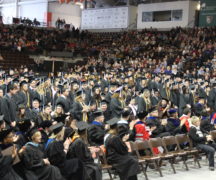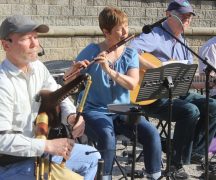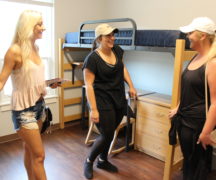By DAVID DUPONT
BG Independent News
Bowling Green State University is only one of two state four-year institutions to post an increase in enrollment this fall.
Cecilia Castellano shared that good news Friday morning with the Board of Trustees. She did not name the other university except to say it wasn’t the one in Columbus – the official numbers will be released in October. Also, retention of last year’s entering class hit an all-time high, 79.4 percent.
Having exceeded expectations in the middle of the pandemic, Castellano said she and her team are not about to rest. She went on to candidly discuss the challenges that lie ahead for BGSU.
“I feel quite a sense of urgency,” she said. “Time does not stand still even though we’re in the middle of a crisis. We have got to take a step forward in shoring up our enrollment for ’21.” If not, “we’ll be stepped over.”
Castellano noted that the enrollment gains were driven by graduate programs and BGSU’s eCampus, which offers online courses that last seven weeks. With another session starting in October, BGSU’ headcount could get another bump up.
Graduate enrollment is up 20 percent, and the eCampus is up more than 90 percent. The university, she said, is going to have to continue to see that kind of growth in those programs.
The number of first year students was down 7 percent , however, and particularly worrisome was the decline in number of first-year students from underrepresented groups and students eligible to receive Pell Grants.
These students, Castellano said, tend to start the application process in March. That’s just when the reality of pandemic hit. She wondered if that didn’t play a role in the lack applicants, especially given economic uncertainties.
She did note that the top scholars who enrolled were more ethnically diverse than in the past.
President Rodney Rogers said this was a note of caution for the university. Maybe, he said, “they’ve given up because of the challenges we’re facing. … These are students we cannot forget. We need to find ways to reengage them and provide them with the opportunities for the next chapter.”
That is essential to the mission of the university, Rogers said.
Keeping these students on campus once they are recruited is a further challenge, Castellano said. Her staff is working closely with the Office of Diversity and Belonging.
Castellano said she has further concerns about future students because of the problems brought on in K-12 education by COVID-19 restrictions. Looking across the state, urban areas are the ones most likely to have remote learning only.
Jennifer McCary, the chief diversity and belonging officer, said enrolling those students from those districts is one thing, but the university needs to look at how courses are structured to retain them. Courses may need to be redesigned to address that gap, which is not an achievement gap, she said, but an opportunity gap.
She also said that the Student Success Council has a student of color retention committee, which in part is looking at what factors have an impact on whether those students remain at BGSU.
Castellano said members of her office’s staff are going around the state to disseminate information about the financial aid process. While those presenters are dressed in Falcon orange, they are not trying to recruit students to BGSU.
While she’d love all students to come to BGSU, Castellano said it’s more important that they find a path to higher education somewhere.
With the decline in first year students, she said, there may be a pent-up demand for the on-campus experience.
Work continues in how to make what BGSU offers stand out so it can hold its own as the number of high school graduates starts to decline in about five years.
Provost Joe Whitehead said while much attention has been focused on helping students manage their course loads during the pandemic through Design My BGSU, the ongoing initiative in Life Design continues.
The goal, he said, is to engage students in a holistic way that connects what they do in the classroom with what they will do once they graduate.
The university has hired six certified Life Design coaches. He said that there are only seven such coaches in Ohio, and BGSU has six of them.
They will teach introductory courses for first year students and have ongoing advising relationships with students. Each will initially advise 150 students, and that’s expected to grow.
They will also develop workshops in design thinking for other students.
Castellano said that some students “are realizing in high school they can learn online.” BGSU has to be ready to offer them quality BGSU courses in that format.
McCary and Whitehead also discussed efforts to create a single course aimed at teaching cultural competence.
The course content, McCary said, would be tailored to provide students what they need to know to be culturally competent. “We’re in process right now of defining cultural competence and what definition makes sense for us, and then looking at how do we talk about some of the real pressing issues in our nation and in our world within a classroom setting that makes sense to all our students.”
Whitehead said those issues now are spread out in various offerings through BG Perspectives. Though those courses may touch on different aspects, a student could still get through without learning all aspects of cultural competence. That, Whitehouse said, includes a grounding in democracy.
The one required course would address this.
The other courses would continue to be offered.
Rogers noted the BGSU was one of the first institutions in Ohio to have a requirement, and this marks a further development along those lines.
McCary also discussed the recent virtual Day of Dialogue, which attracted about 8,500 participants between Facebook Live and YouTube. The event gave the community a chance to address issues of racial justice that have roiled the nation in the past six months.
The presentations were varied including a session on civic engagement, a session on what resources are in the library’s archives, a conversation between Rogers and Whitehead, and a keynote speech by McKinley Melton that used poetry to drive home the point that “it’s our business to bring about change.”
Betty Montgomery, who chairs the trustees, said she was “blown away by the participation” She continued: “It sounds like you are helping coping in a very difficult time for the minority community, for all of us.” She encouraged McCary to hold another.
Later in the meeting, Pam Conlin, vice president for University Advancement, said that through trustee Ava Harter, BGSU is finalizing an agreement with Owens-Corning and for “a significant seven figure gift” to support scholarships for underrepresented populations in the School of the Built Environment.
Harter, senior vice president, general counsel and secretary at Owens-Corning, said that the company is committed to efforts to address social and racial inequities especially in the areas of affordable housing, education, and developing talent. “There’s no better partner than Bowling Green State University in Northwest Ohio.”





